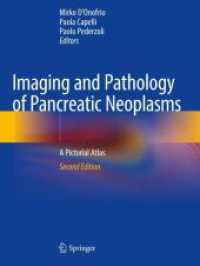- ホーム
- > 洋書
- > ドイツ書
- > Mathematics, Sciences & Technology
- > Biology
- > popular works
Full Description
This book entails detailed information on the utilization of nanobiosensor as an effective technology for the effective detection, monitoring, and management of environmental contaminations to ensure its sustainability and humanity's well-being. The higher level of anthropogenic action has been identified as a threat to humankind's existence due to the higher level of xenobiotic and toxic substances that could interrupt the normal ecosystem. This has prompted numerous agencies both locally and internationally that could play a significant role in environmental pollution mitigation. The application of nanobiosensor has been identified as a sustainable technique that could be applied to ensure proper detection and identification of several environmental contaminants. Nanomaterial's possible applications created an innovative domain called nanomaterials based biosensors machinery as one of nanotechnology's ultimate sub-divisions. The application of nanomaterials based biosensorsmachinery and their advancements could be applied globally to resolve numerous environmental sectors' challenges to guarantee the environment's quality and safety.
The book will be an excellent collection of reviews based on contemporary research and developments on nanomaterials utilization and applications in environmental monitoring along with their prospects. The book will attempt to give a comprehensive idea of nanomaterial concepts for nanobiosensors applications in an environmental context to help students, researchers, and professionals/practitioners recognize nanomaterials' significance in the environmental domain. The book will also help understand and address the environmental sectors' complications via nanomaterials' utilization and applications. Hence, this book will serve as a textbook and will help students, professionals/practitioners, scientists, researchers, and academicians in various research domains.
Contents
Chapter 1. Introduction to Nanobiosensors.- Chapter 2. Classification, properties, and fabrication techniques of nanobiosensors.- Chapter 3. Nanobiosensors potentialities for environmental monitoring.- Chapter 4. Utilization of nanobiosensors for wastewater management.- Chapter 5. Nanobiosensors for Environmental Risk Assessment and Management.- Chapter 6. Challenges and Scope in Nanobiosensors Utilization for Environmental Monitoring.- Chapter 7. Role and Significance of Nanobiosensors for Environmental Remediation.- Chapter 8. Bioluminescence Sensors for Environmental Monitoring.- Chapter 9. Microbial and plant cell biosensors for environmental monitoring.- Chapter 10. Biomimetic material based biosensor for environmental monitoring.- Chapter 11. Chemiluminescence sensors for environmental monitoring.- Chapter 12. Nanobiosensor for mycotoxin detection in foodstuff.- Chapter 13. Current Existing Techniques for Environmental Monitoring.- Chapter 14. Molecularly imprinted polymers-based nano-biosensors for environmental monitoring and analysis.- Chapter 15. Plasmonic nanoparticles for naked-eye detection of environmental pollutants.- Chapter 16. Utility of nanobiosensors for heavy metal contamination detection in the environment.- Chapter 17. Nanobiosensors and Industrial Wastewater Treatments.- Chapter 18. Nanobiosensors potentialities for monitoring SARS-CoV-2 in the environment.- Chapter 19. Recent trends in rapid environmental monitoring of toxicants using nanobiosensors.- Chapter 20. Ecotoxicology of nanomaterials: a sensor perspective.- Chapter 21. Legal Implications of Nanobiosensors Concerning Environmental Monitoring.







